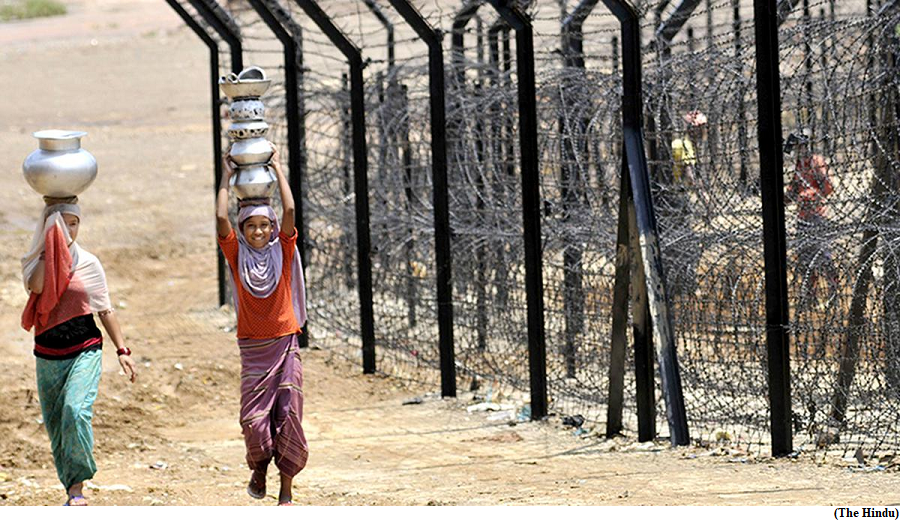Mountain goats in Alps are turning nocturnal due to climate impact, making them more vulnerable to predators (GS Paper 3, Environment)

Why in news?
- Warmer temperatures caused by climate change are changing the lifestyles of mountain goats in the European Alps.
- Alpine ibexes (Capra ibex), a mountain goat species, are forced to change their diurnal habits to nocturnal to avoid hot days. This lifestyle shift is making them vulnerable to predators such as wolves, hindering their movement and may lead to eventual population decline.
Details:
- The researchers from the University of Sassari and University of Ferrara in Italy studied 47 ibexes over a span of 14 years.
- The study is titled ‘Seeking temporal refugia to heat stress: increasing nocturnal activity despite predation risk’.
- The goats were tracked between 2006 and 2019 using motion sensors and global positioning system trackers.
Key Findings:
- The ibexes’ nocturnal activities increased during warmer days and brighter nights due to moon illuminance, the researchers noted.
- Migration to favourable areas can be hindered by the widespread presence of humans or the landscape structure. In such cases, animals may maintain their current distribution range and optimal thermal niche by modifying their ecological niche in the temporal dimension, i.e. their daily activity rhythms.
- The animals do this to achieve energy balance and efficient heat dissipation due to the cooler evening hours.
- Males and females were active during nocturnal hours, but with females less active when accompanied by a kid. However, ibex activity was considerably higher in areas having the presence of nocturnal predators.
Shift to nocturnal lifestyle:
- The shift in behavioural pattern is the primary evidence stating that animals are avoiding heat stress and adopting nocturnal activity and, in the process, increasing predation risks.
- Apart from climate change, other pressures such as human activities, urban development, agriculture, hunting and others are also driving global increase in nocturnal activity of mammal species.
- However, a mismatch between animal adaptations and environmental conditions may occur due to a shift to a nocturnal lifestyle, which may impact the animals in the long run. The change in activity time may disrupt inter-related aspects such as competition and parasitism.
Conclusion:
- This shift towards nocturnality may facilitate animal adaptations to anthropogenic global change; on the other hand, it may bring negative consequences at individual, population and community levels.
- When active at night, diurnally adapted mammals may suffer from reduced foraging efficiency, weakened antipredator behaviours, restricted movement capacity, and ultimately reduced reproduction and survival rates.
- Such changes may further hinder humans’ ability to detect animals for population estimates, affecting conservation planning.
Centre releases three drug regimen for treating leprosy
(GS Paper 2, Health)
Why in news?
- The Union government has approved a new treatment regimen for leprosy, aiming at stopping its transmission at the sub-national level by 2027.

Details:
- The Ministry of Health and Family Welfare has decided to introduce a three-drug regimen for Pauci-Bacillary (PB) cases in place of a two-drug regimen for six months.
- The move follows the “latest, globally accepted scientific research studies and evidence-based practices”.
- The World Health Organization (WHO) had agreed to supply the revised drug regimen from April 1, 2025. Thus, all States and Union Territories have now been asked to send their requisitions for anti-leprosy drugs 12 months beforehand.
- The revised classification of leprosy and the treatment regimen for PB and multi-bacillary (MB) cases in India will be implemented from the same date.
About leprosy:
- The leprosy is a chronic infectious disease caused by Mycobacterium leprae.
- The bacteria are transmitted via droplets from the nose and mouth during close and frequent contact with untreated cases.
- Leprosy, reported from all the six WHO regions, is curable with multi-drug therapy (MDT). The majority of new cases detected are from Southeast Asia.
MDT:
- The WHO’s recommended treatment regimen consists of three drugs — dapsone, rifampicin and clofazimine. The combination is referred to as MDT.
- The duration of treatment is six months for PB and 12 months for MB cases. MDT kills the pathogen and cures the infection.
- The WHO has been providing MDT free of cost. Free MDT was initially funded by the Nippon Foundation and since 2000, it has been donated through an agreement with Novartis. This regimen is known as ‘Uniform MDT’, where a single three-pack kit can be given to all leprosy patients.
Reconsidering the free movement regime
(GS Paper 2, International Relation)
Why in news?
- At a passing out parade of the Assam police commandos in Guwahati, Union Home Minister said the 1,643 km India-Myanmar border would soon be fenced.
- He also said the Free Movement Regime (FMR) agreement with Myanmar would be reconsidered to stop border residents from moving into each other’s country without any paperwork.

Background:
- Much of India’s present-day northeast was temporarily under Burmese occupation until the British pushed them out in the 1800s. The victors and the vanquished signed the Treaty of Yandaboo in 1826, leading to the current alignment of the boundary between India and Burma, later renamed Myanmar.
- The border divided people of the same ethnicity and culture specifically the Nagas of Nagaland and Manipur and the Kuki-Chin-Mizo communities of Manipur and Mizoram without their consent. In some stretches, the border split a village or a house between the two countries.
What is the FMR?
- The FMR came about in 2018 as part of the Narendra Modi government’s Act East policy. The Rohingya refugee crisis that began in August 2017 caused the delay.
- The FMR allows people living on either side of the border to travel up to 16 km inside each other’s country without a visa. A border resident needs to have a border pass, valid for a year, to stay in the other country for about two weeks per visit.
- The FMR also envisaged the promotion of localised border trade through customs stations and designated markets apart from helping the people of Myanmar access better education and healthcare facilities on the Indian side of the border.
Why is the FMR being reconsidered?
- Apart from a 10 km stretch in Manipur, the India-Myanmar border through hills and jungles is unfenced. The security forces have for decades grappled with members of extremist groups carrying out hit-and-run operations from their clandestine bases in the Chin and Sagaing regions of Myanmar.
- The ease of cross-border movement, even before the FMR was in place, was often flagged for inward trafficking of drugs and outward trafficking of wildlife body parts.
- The trigger for the rethink on the FMR was the conflict that broke out between the majority Meitei and the tribal Kuki-Zo communities in Manipur on May 3, 2023.
- Over the past decade, the Manipur government has been expressing concern over the “influx” of Myanmar nationals, a euphemism for Kuki-Chins, calling for an Assam-like National Register of Citizens to weed out the “illegal immigrants”.
- The theory gained currency after the conflict, which coincided with a few hundred Myanmar nationals taking refuge in Manipur to escape a civil war back home.
- In September 2023, Manipur Chief Minister Nongthombam Biren Singh blamed the ethnic violence on the free movement of Myanmar nationals into India and urged the Ministry of Home Affairs to end the FMR, which had been suspended on April 1, 2020, during the COVID-19 lockdown.
- The suspension was extended after the military coup in Myanmar in February 2021. Kuki-Zo organisations, on the other hand, have accused the Chief Minister of branding the community as “illegal immigrants” and “narco-terrorists” to justify their “ethnic cleansing”.
What is the scale of migration?
- The civil war in Myanmar saw a drastic jump in the number of people seeking refuge in India. In September 2022, authorities in Manipur pushed back 4,300 of some 5,500 Myanmar nationals from the Moreh area along the border after recording their biometrics.
- A committee set up by the State government put the number of such migrants in 2023 at 2,187.
- The civil war in the neighbouring country also forced some 40,000 people into Mizoram, who, unlike Manipur, made them feel at home primarily due to their ethnic affiliation.
- The Mizoram government has been seeking funds from the Centre to look after the displaced people who it wants to be sent back only after the situation in their country normalises.
Why are Mizoram and Nagaland opposed to ending the FMR?
- Mizoram Chief Minister Lalduhoma said his government does not have the authority to stop the Centre from fencing the India-Myanmar border for perceived security threat and scrapping the FMR, but said he was opposed to the move.
- According to him, the border was imposed by the British to divide the people belonging to the Zo ethnic stock.
- The Naga Students’ Federation condemned the Centre’s move. It said that it is crucial for India to acknowledge the historical truth that these territories (between the Chindwin River in Myanmar and the Saramati mountain in Nagaland) belong to the Nagas.




